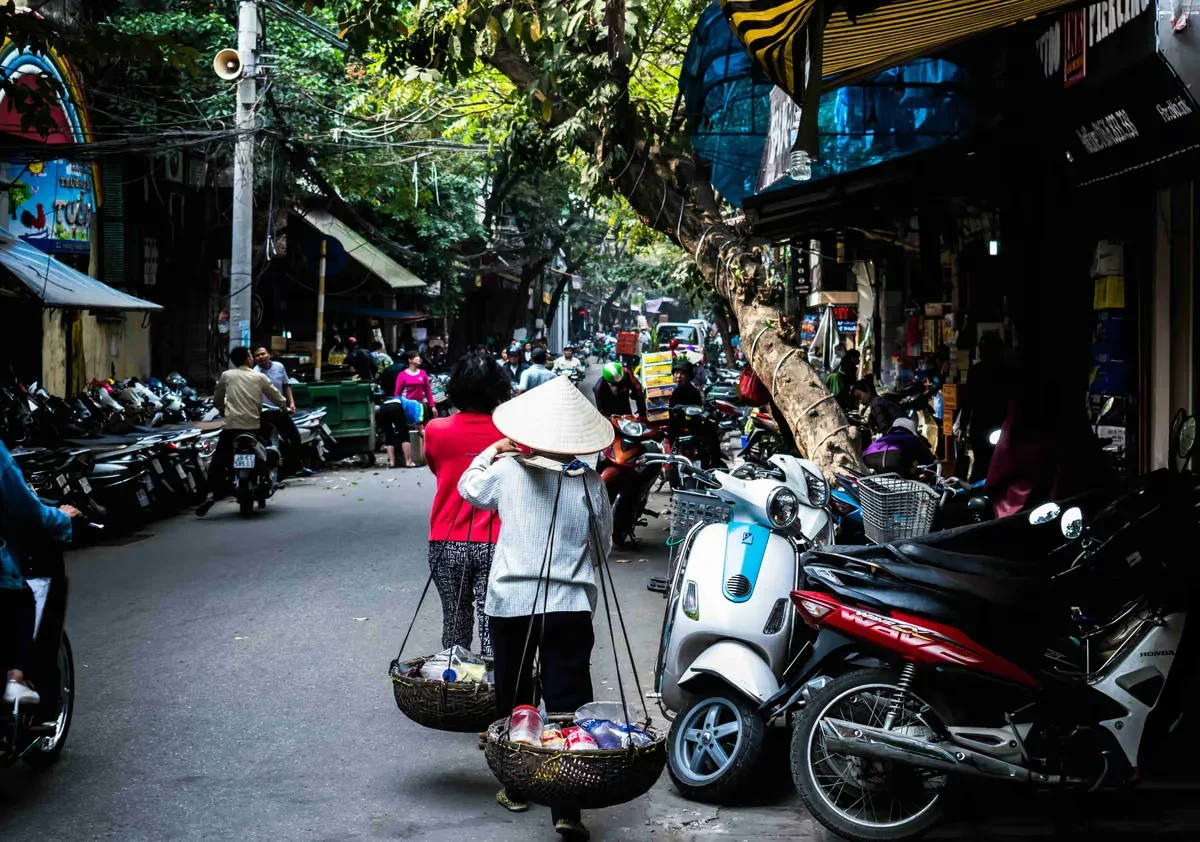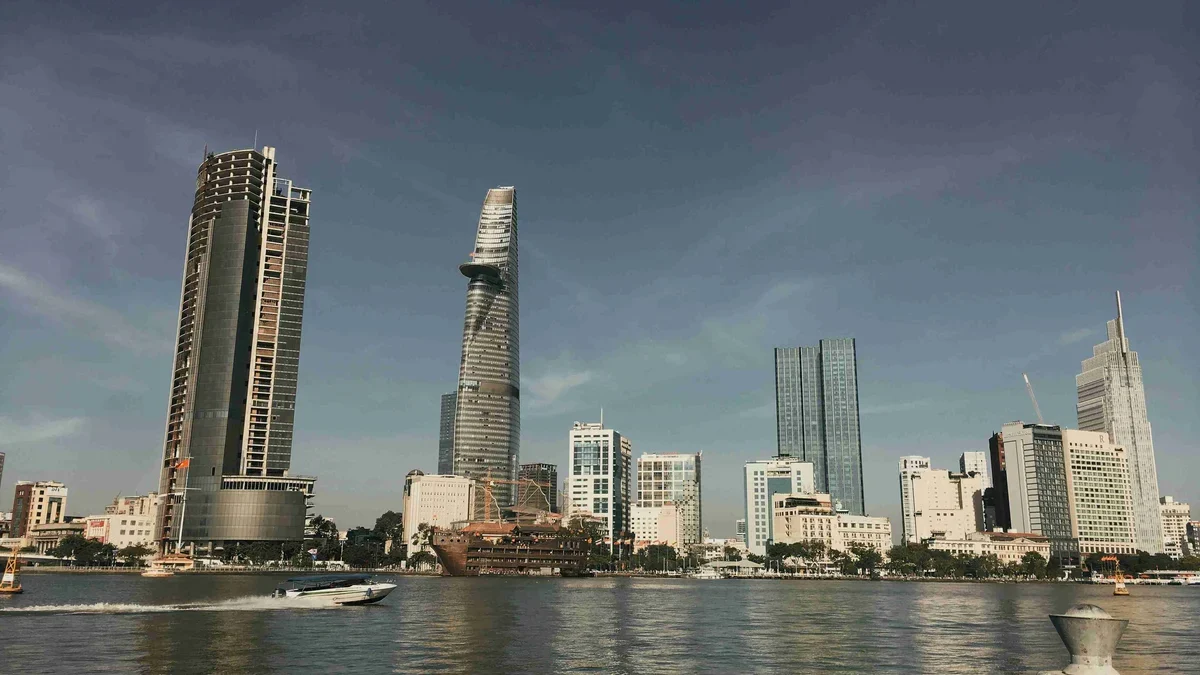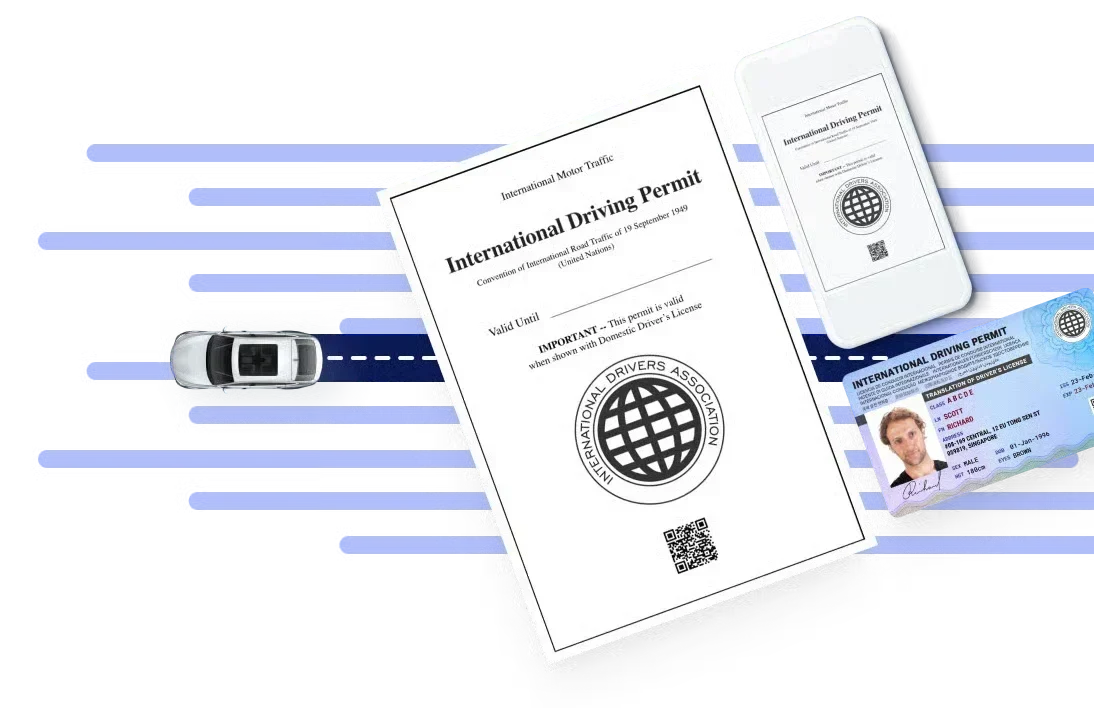Exploring Vietnam is an adventure best experienced through its diverse public transportation options. From Hanoi to Ho Chi Minh City, buses, trains, and motorbikes offer convenient ways to get around and dive into local life. Public buses and sleeper trains provide budget-friendly travel across cities like Da Nang and Nha Trang, while Vietnam Airlines connects major destinations quickly. Whether you’re navigating the vibrant streets on a motorbike or taking a sleeper train for longer journeys, using transportation in Vietnam is an excellent way to see the country’s rich culture and stunning landscapes.
Motorbikes
Motorbikes are the backbone of transportation in Vietnam, particularly in bustling cities like Ho Chi Minh City and Hanoi. They are a versatile mode of transport used for daily commuting, running errands, and even transporting goods and passengers. Motorbikes are favored for their maneuverability in heavy traffic and their ability to navigate narrow streets.
Fares:
- Rental Rates: Renting a motorbike typically costs between VND 100,000 to VND 300,000 per day, depending on the bike’s model and rental duration.
- Taxi Services: For motorbike taxis (xe om), fares generally range from VND 15,000 to VND 50,000 for short trips, though prices can vary based on distance and traffic conditions.
Payment Options:
- Rental Payments: Cash is commonly used for motorbike rentals. Some rental agencies may accept digital payments via mobile apps.
- Ride-Hailing Apps: Services like Grab and Gojek offer convenient payment options through their apps, allowing you to pay with credit/debit cards or mobile wallets.
Motorbikes provide a flexible and economical way to explore Vietnam, offering an authentic experience of local life and culture.

Source: Photo by Son Vu Le on Unsplash
Buses in Vietnam
Buses are a convenient and budget-friendly way to explore Vietnam, whether navigating urban areas or traveling between cities. City buses provide an economical option for local commuting, while intercity buses offer comfortable journeys across the country’s major routes.
City Buses
- Details: City buses offer an affordable way to travel within urban areas like Hanoi, Ho Chi Minh City, and Da Nang. They are ideal for short trips and daily commuting.
- Fares: Typically range from VND 5,000 to VND 15,000 per ride.
- Payment Options: Cash is required on the bus; exact fare is needed.
Here are some of the major public city bus lines that operate in Vietnam:
1. Hanoi Public Bus System (Transerco): Operates an extensive network of buses within Hanoi, covering most districts and popular tourist spots.
2. Ho Chi Minh City Bus System (Saigon Bus): Provides comprehensive bus services across Ho Chi Minh City, including routes to Tan Son Nhat Airport and major landmarks.
3. Da Nang Bus System: Manages bus services within Da Nang city, with routes connecting the airport, beaches, and city center.
4. Hai Phong Bus System: Covers routes throughout the city of Hai Phong, including connections to nearby attractions and coastal areas.
5. Can Tho City Bus System: Offers transportation within Can Tho and connections to the Mekong Delta region.
Intercity Buses
- Details: Intercity buses connect major cities and towns across Vietnam, making them a popular choice for longer journeys.
- Fares: Generally between VND 200,000 to VND 600,000, depending on distance and service class.
- Payment Options: Tickets can be bought online, at bus stations, or through travel agencies.
Here are some of the major public city bus lines that operate in Vietnam:
1. Futa Bus Lines (Phuong Trang): One of the largest intercity bus companies, offering routes between major cities such as Ho Chi Minh City, Da Lat, Nha Trang, and Mekong Delta provinces.
2. Mai Linh Express: Provides long-distance bus services between key cities like Hanoi, Da Nang, and Ho Chi Minh City.
3. The Sinh Tourist (Sinh Cafe): Famous among tourists, offering intercity routes from Hanoi to Ho Chi Minh City and popular destinations like Hue and Hoi An.
4. Hoang Long Bus: Offers intercity connections, particularly popular for routes from Hanoi to Ho Chi Minh City with stops in major cities along the way.
5. Hanh Cafe: Specializes in coastal routes from Ho Chi Minh City to Nha Trang, Mui Ne, and Da Lat.

Source: Photo by Edwin Petrus on Unsplash
Taking the Train in Vietnam
Operated by Vietnam Railways, trains offer a scenic and relaxing way to travel across Vietnam. They connect major cities like Hanoi, Ho Chi Minh City, and Sapa, with options ranging from basic to luxury services. The train routes are known for their beautiful views, especially on longer journeys.
Fares: Prices range from VND 300,000 for standard seats on short routes to VND 2,000,000 for higher-class accommodations on longer trips. The fare depends on the train class, distance, and the type of berth or seat you choose.
Payment Options: Tickets can be purchased online through Vietnam Railways ‘ website, at train stations, or through travel agencies. Cash and card payments are accepted at stations, while online purchases typically require card payments.
Here are the major train lines that operate in Vietnam:
1. North-South Railway (Reunification Express)
- Route: Hanoi to Ho Chi Minh City (Sài Gòn)
- Details: The most popular and longest railway line in Vietnam, connecting the north to the south. It passes through major cities such as Huế, Da Nang, Nha Trang, and many more.
2. Hanoi to Lao Cai Line
- Route: Hanoi to Lao Cai (Sapa)
- Details: A scenic train route leading to the northern highlands, popular with travelers heading to the mountainous region of Sapa.
3. Hanoi to Hai Phong Line
- Route: Hanoi to Hai Phong
- Details: Connects the capital city to the port city of Hai Phong, which is a gateway to the famous Ha Long Bay.
4. Hanoi to Dong Dang Line
- Route: Hanoi to Dong Dang (near the Chinese border)
- Details: A train line that runs to the northern border town of Dong Dang, facilitating travel to China via the international railway link.
5. Saigon to Quang Ngai Line
- Route: Ho Chi Minh City to Quang Ngai
- Details: An important segment of the North-South Railway, serving southern cities and provinces, offering access to smaller towns along the route.
Vietnam in a Cab
Taxis are readily available in cities across Vietnam, providing a convenient and private way to travel short distances or for personalized trips. They are ideal for getting around urban areas quickly and comfortably.
Fares: Metered fares generally start at around VND 40,000, with an additional charge of approximately VND 12,000 per kilometer. Some companies may also include surcharges for late-night rides or airport transfers.
Payment Options: Payment is typically made in cash, but many taxis now accept credit cards. Ride-hailing apps like Grab offer a seamless option for digital payments, allowing you to pay via the app using various methods, including credit/debit cards and mobile wallets.
Here are some of the major cab companies that operate in Vietnam:
1. Mai Linh Taxi: One of the largest and most recognized taxi companies in Vietnam, operating in many cities including Hanoi, Ho Chi Minh City, and Da Nang.
2. Vinasun Taxi: A popular and reliable taxi service, particularly strong in Ho Chi Minh City and the southern provinces.
3. Thanh Cong Taxi: Operating mainly in the northern cities like Hanoi and Ha Long Bay.
4. Hanoi Taxi Group: A prominent service in the capital city, Hanoi, known for its accessibility and reliability.
5. Vinataxi: Operating in Ho Chi Minh City, this service is known for its consistent and widespread coverage across the city.
Ride-Hailing Apps
Ride-hailing apps like Grab are highly popular in Vietnam for their convenience and reliability. They provide a range of services, including motorbike taxis, private cars, and even food and parcel delivery. Users can easily book rides through the app and track their driver in real time.
Fares: Costs vary based on factors such as distance, demand, and the type of service chosen. For motorbike taxis, fares typically range from VND 20,000 to VND 50,000 for short trips, while car rides can vary from VND 50,000 to VND 100,000 or more for longer distances.
Payment Options: Payments are made digitally through the app. Users can pay using credit/debit cards, mobile wallets (such as MoMo or ZaloPay ), or through Grab’s e-wallet system. This eliminates the need for cash and ensures a smooth, cashless transaction.
Cyclo (Pedicabs)
Cyclos are traditional three-wheeled bicycles with a passenger seat in the front, offering a unique and leisurely way to explore tourist areas in Vietnam. They are commonly found in cities like Hanoi and Ho Chi Minh City, providing a charming, open-air experience ideal for short, scenic rides.
Fares: The cost for a cyclo ride is usually negotiable and typically ranges from VND 50,000 to VND 150,000, depending on the distance and duration of the trip. It’s advisable to agree on the fare before starting the ride to avoid any misunderstandings.
Payment Options: Payments are made in cash. Ensure you carry sufficient cash and small denominations, as many cyclo drivers may not have changed.
Boats & Ferries
Boats and ferries are essential for navigating Vietnam’s coastal areas and river regions. In cities like Ho Chi Minh City, boat services operate on the Saigon River, offering scenic routes and a unique perspective of the city. They are also commonly used for reaching islands and exploring Vietnam’s waterways.
Fares: Boat and ferry fares typically range from VND 30,000 to VND 150,000, depending on the route, distance, and type of service. Shorter trips or local routes are on the lower end of the scale, while longer or more scenic routes may cost more.
Payment Options: Payment is generally made in cash at the dock or directly on the boat. It’s a good idea to carry enough cash in small denominations as some services may not accept card payments or provide change.
Here are some of the major ferry services and companies operating in Vietnam:
1. Superdong Fast Ferry: Popular for routes between mainland Vietnam and islands such as Phu Quoc and Con Dao.
2. Greenlines: Operates high-speed ferries between Ho Chi Minh City, Vung Tau, and the Mekong Delta.
3. Phu Quoc Express: Offers fast ferry services connecting Phu Quoc Island with Rach Gia and Ha Tien.
4. Vina Express: Provides ferry services between Ho Chi Minh City and Vung Tau.
5. Hai Au Express: This specializes in ferry routes to Cat Ba Island from Hai Phong and Ha Long Bay.
Air Travel
Vietnam’s air travel is primarily serviced by major airlines such as Vietnam Airlines, VietJet Air, and Bamboo Airways. These airlines connect major cities like Hanoi, Ho Chi Minh City, Da Nang, and Nha Trang, as well as popular tourist destinations and islands. Domestic flights are a quick and efficient way to cover long distances across the country, offering various options from budget to premium services.
Fares: Airfare prices vary significantly depending on the destination, time of booking, and class of service. Typical fares range from VND 500,000 to VND 2,000,000. Booking in advance often yields lower prices, and budget airlines like VietJet Air frequently offer promotional deals.
Payment Options: Tickets can be purchased using credit/debit cards through airline websites, travel agencies, and booking platforms. Online payment methods, including e-wallets, are also commonly accepted. For ticket purchases at airport counters, cash and card payments are generally accepted.
Car Rental
Car rental in Vietnam provides a flexible and convenient way to explore the country at your own pace. Options range from small economy cars to larger SUVs and luxury vehicles. Rentals are available in major cities like Hanoi, Ho Chi Minh City, and Da Nang, as well as popular tourist spots. While driving in Vietnam can be challenging due to traffic and road conditions, renting a car is a great option for those looking to venture beyond urban areas.
Fares: Rental rates typically range from VND 400,000 to VND 1,500,000 per day, depending on the type of vehicle, rental duration, and season. Rates may vary based on insurance coverage and additional features such as GPS or child seats.
Payment Options: Payments for car rentals are usually made via credit/debit cards. Some rental companies may accept cash or bank transfers, but card payments are preferred for security and convenience. A deposit is often required at the time of rental, which is refundable upon return of the vehicle in good condition.
Requirements:
- A valid Universal driving permit in Vietnam, international driving permit (IDP) or Vietnamese driver’s license.
- A passport and a credit card for the deposit.
- Be aware of local driving laws in Vietnam and driving conditions.
Here are the top 5 car rental companies in Vietnam:
1. Avis Vietnam
2. Hertz Vietnam
3. Budget Vietnam
4. Thrifty Vietnam
5. Sixt Vietnam
FAQs for Tourists About Transportation in Vietnam
Traveling around Vietnam using public transportation can be a rewarding experience. Here are some tips to make your journey smoother:
1. Know the Local Transport Options: Vietnam offers various modes of public transportation, including buses, trains, taxis, motorbike taxis, and ride-hailing apps. Familiarize yourself with these options to choose the best one for your needs.
2. Plan Your Routes: Public transport routes, especially buses and trains, might not always be straightforward. Use apps or maps to plan your route in advance, and consider asking locals for advice if you’re unsure.
3. Carry Cash: While digital payments are becoming more common, many buses and local taxis only accept cash. Always carry small denominations to cover fares.
4. Use Ride-Hailing Apps: Apps like Grab can simplify travel in cities by providing clear pricing and eliminating the need for cash. They also offer options for both motorbike taxis and cars.
5. Be Prepared for Traffic: Traffic congestion can be an issue, particularly in cities like Hanoi and Ho Chi Minh City. Plan for potential delays, especially during peak hours.
6. Keep Your Valuables Safe: Public transportation can be crowded, so keep an eye on your belongings and avoid displaying expensive items.
7. Understand Local Etiquette: Be respectful of local customs. For example, in many places, it’s customary to remove your shoes before entering certain public transport areas or businesses.
8. Check for Discounts: Some transportation services offer discounts for tourists or group bookings. Inquire about any available discounts when purchasing tickets.
9. Comfort Matters: For longer trips, consider traveling during off-peak hours or booking higher-class services like sleeper trains to ensure comfort.
10. Verify Safety Standards: Ensure that the vehicles, especially for hire, meet safety standards. Look for reputable companies and read reviews if possible.
FAQs for Tourists About Transportation in Vietnam
How can I get around cities like Hanoi and Ho Chi Minh City?
In major cities, you can use public buses, taxis, motorbike taxis, or ride-hailing apps like Grab. Renting a motorbike is also popular for exploring at your own pace.
Are there any tips for using public buses in Vietnam?
Buses in cities are affordable, but routes can be complex. Use local apps or maps for route planning and carry cash for payment.
Are there options for traveling between cities?
Intercity buses and trains are common for long-distance travel. Domestic flights are also available and can save time. Ferries and boats are used for routes involving islands or coastal areas.
What payment methods are accepted for transportation?
Public buses and local taxis usually require cash. Ride-hailing apps accept digital payments. Car rentals and flights can be paid for with credit/debit cards.
Are there safety tips for using public transportation?
Keep an eye on your belongings, especially in crowded areas. Use reputable services and avoid traveling late at night if you’re unfamiliar with the area.
How can I find information about public transportation schedules?
Schedules can be found on transportation company websites, local apps, or by asking at your hotel or local tourist information centers.
What should I do if I have a problem with a transportation service?
Contact the service provider directly through their customer service hotline or app. For major issues, you can also seek assistance from local authorities or your embassy.







